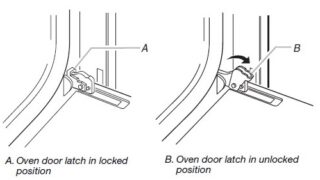Jenn-Air Oven door repair
TO REMOVE JENN-AIR OVEN DOORS WITH HINGE LATCHES
- Prior to removing oven door, prepare a flat surface to place the oven door. It should be covered with a soft blanket, or use posts from packing material.
- Open the oven door.
- Locate oven door hinge locks / latches in both corners of oven door.
- Rotate / flip up hinge lock / latch toward oven door to unlocked position.
- If door hinge lock / latch is not rotated / flipped fully (see illustration B), door will not remove properly.
- NOTE: Hinge lock / latch will vary depending on model number.

- Partially close door to engage door latch locks. Door will stop at this point.

- Using two hands, grasp edges of oven door.
- Lift and pull oven door toward you and remove.
- The door may need to be gently shifted from side to side as you pull the door.

- Set oven door(s) aside on prepared covered work surface, with oven door resting on its handle.
HOW TO REPLACE AN JENN-AIR OVEN DOOR WITH HINGE LATCHES
- Using two hands, grasp side edges of door at midpoint. Face oven cavity.
- Locate slots on each side of oven cavity for door hinge locks.

- At a 45° angle, align door hinges with slots in lower front of oven cavity.
- Slowly insert door while maintaining 45° angle.
- The door is engaged in the slot when you feel a slight drop.

- Lower oven door to fully open position:
- If oven door does not open to full 90°, repeat steps 1 – 3.
- Locate the oven door hinge locks / latches in corners of oven door and rotate hinge locks / latches toward oven cavity to locked position.
- See Step 3 (Illustration A) in the “Remove Oven Door(s)” section for proper locked position.

- Close oven door.
- When hinges are properly installed and door is closed, there should be an even gap between door and control panel:
- If one side of oven door is hanging lower than other side, hinge on that side is not properly installed
- Repeat the steps to remove and replace oven door
TO REMOVE JENN-AIR OVEN DOOR WITHOUT HINGE LATCHES
- Prior to removing oven door, prepare a flat surface to place the oven door. It should be covered with a soft blanket, or posts from packing material.
- Open oven door to the first stop position (opened about 4″ [10.0 cm]).
- Grasp the door at each side. Do not use the door handle to lift the door.
- Evenly lift the door until it clears the hinge arms.
TO REPLACE JENN-AIR OVEN DOOR WITHOUT HINGE LATCHES
- Grasp door at each side.
- Align slots in the door with the hinge arms on the range.
- Slide the door down onto the hinge arms until the door is completely seated on the hinges.
- Push down on the top corners of the door to completely seat door on hinges.
NOTE: The door should not appear crooked.

